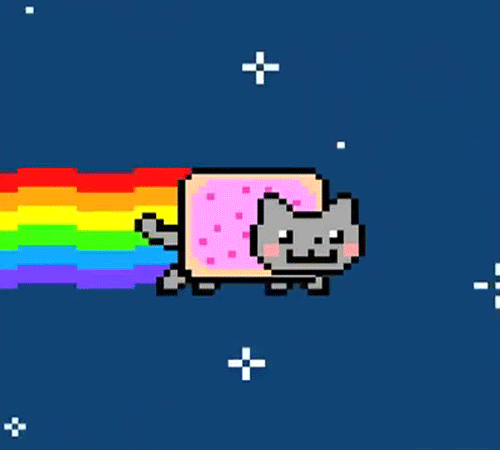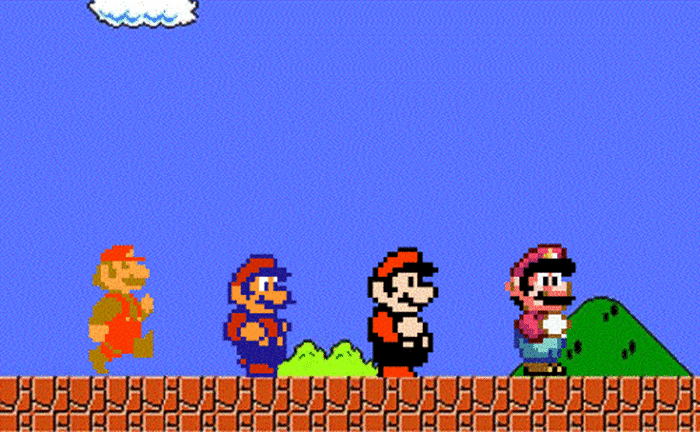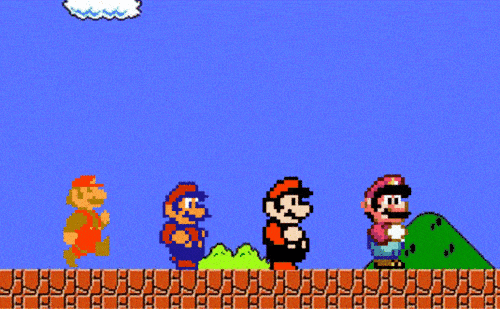Exploring Animated GIFs: Optimization, Compression, and Conversion
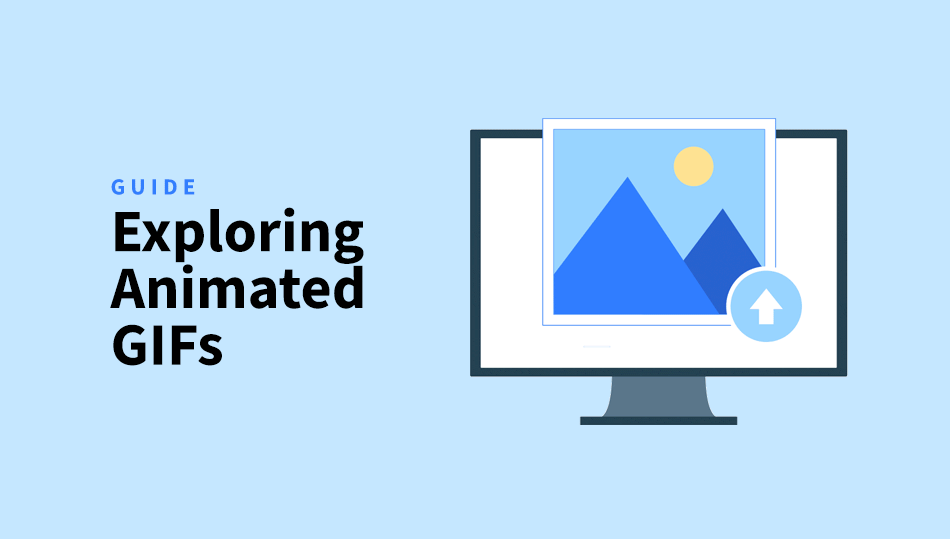
Animated GIFs enhance our online encounters with their snappy, looping animations.
But what defines animated GIFs, and what fuels their widespread appeal?
In this post, we’ll explore what animated GIFs are, why they are so popular, their technical limitations, and how to effectively manage and compress them.
Quick Takeaways
- Animated GIFs are engaging, looping visuals widely used in online interactions but have technical limitations like large file sizes and limited color depth.
- They remain popular for their shareability, nostalgic appeal, and ability to communicate effectively in social contexts.
- Optimize GIFs for performance by compressing, resizing, reducing frames, or converting to modern formats like WebP or AVIF with tools like ShortPixel.
What is a GIF?
GIF, short for Graphics Interchange Format, is a raster file format ideal for simple internet images. It supports up to 8 bits per pixel and holds 256 indexed colors. GIFs can have images or frames combined for basic animations, utilizing the .gif extension.
Originally introduced in the late 1980s, GIFs were created as a means to display short, animated sequences on the internet.
Their simplicity and compatibility made them accessible across various platforms, sparking their initial popularity. However, as technology advanced, GIFs faced a decline, considered outdated due to their limited color palette and bulky file sizes.
Yet, these animated GIFs (looping animations) staged a triumphant comeback in the mid-2010s, riding the wave of internet culture.
They found a new home on social media, messaging platforms, and forums, reviving their relevance. What was once a pixelated, clunky format evolved into an expressive form of visual communication.
Why are animated GIFs popular?

Maybe you’ve been wondering – why GIF?
Understanding what is GIF file helps in knowing why this format is so popular.
These short, animated loops have become an integral part of our online interactions, including on social media, messaging apps, and beyond.
The compact nature makes GIFs incredibly shareable. They grab attention instantly, serving as engaging snippets that demand minimal time commitment from viewers.
Basically, this effortless shareability contributes to their virality, spreading across social platforms like wildfire, prominently being featured on social media platforms like Twitter, Reddit, and Tumblr, serving as reactions, or memes.
Over time, animated GIFs have evolved into a language of internet culture, spawning memes, trends, and inside jokes.
They capture fleeting moments from movies, TV shows, or real-life events, creating a cultural currency that resonates with online communities. The ability to remix and repurpose GIFs contributes to their relevance and adaptability.
Animated GIFs seamlessly integrate into various digital platforms, from social media timelines to messaging apps and forums.
They serve as reactions in comment threads, enhance storytelling in articles, and add a playful touch to personal conversations, making them a versatile tool for communication in diverse online spaces.

Lastly, the pixelated, retro charm of some animated GIFs taps into nostalgia for the early days of the internet. This vintage aesthetic, coupled with their quirky and often humorous content, appeals to audiences across generations, creating a sense of familiarity and comfort.
Technical details and limitations
One of the primary limitations of GIFs lies in their color representation. Constrained by a palette of only 256 colors, these images often struggle to accurately depict the richness and subtlety of colors, particularly evident in photographs and images with complex color gradients. This restricted color range frequently leads to a noticeable degradation in image quality, as the format struggles to render detailed or realistic visuals.
The lossless compression algorithm employed by GIFs, known as LZW, while revolutionary at its inception, now pales compared to modern compression algorithms used in more recent image formats. This dated compression technique contributes to larger file sizes, diminishing the format’s practicality in an era where data optimization and bandwidth conservation are very important.
As technology advances and demands for higher-quality visual content, the limitations of the GIF format become very visible. The inability to accurately portray a wide spectrum of colors and the inefficient compression technique hinder its effectiveness in conveying details and nuances.
While animated GIFs continue to hold a nostalgic charm and retain utility in certain contexts, their technical restrictions have spurred the evolution and adoption of newer formats better equipped to handle the demands of modern multimedia content creation and consumption.
For instance, formats like WebP and AVIF offer superior color depth, better compression methods, and improved support for animations, surpassing the limitations that the .gif file format inherently carries, as we’ll see below.
How to compress GIF online?
Reducing the size of a GIF file, especially when confronted with larger file sizes that could potentially impact website loading times or storage capacity, can be effectively managed through various online tools.
Among these, ShortPixel‘s online compressor stands out as a great solution to compress animated GIF files while maintaining a balance between file size reduction and preserving image quality.
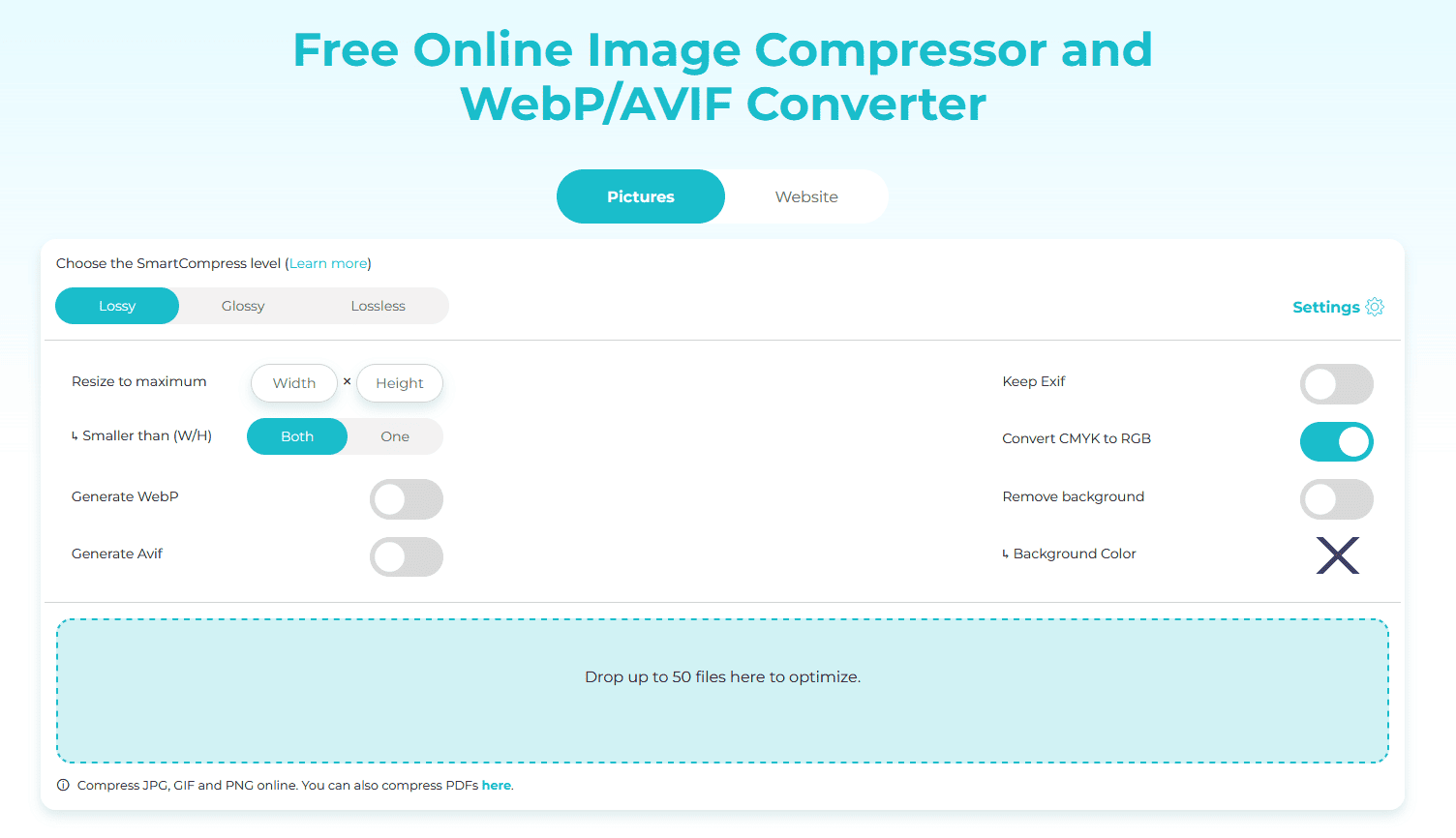
ShortPixel uses a suite of advanced compression algorithms. These algorithms work intelligently to analyze the image data, identifying redundancies and areas that can be optimized without compromising the visual integrity of the GIF.
By selectively compressing and rearranging data within the file, ShortPixel can significantly reduce the file size while retaining the quality of the original image.
This balance between size reduction and image quality ensures that the optimized animated GIFs maintain a satisfactory level of visual appeal to preserve the intended impact of the animation or image.
How to optimize a GIF file on WordPress?
Using a WordPress image compression plugin
Fortunately, optimizing images on your WordPress site is a breeze, thanks to ShortPixel Image Optimizer.
This plugin allows WordPress website owners to easily optimize not just images but also GIF files.
Start by installing the ShortPixel Image Optimizer plugin on your WordPress site by following a step-by-step guide.
Once everything is set up, you can optimize all existing images, including GIFs, in your media library by running the bulk optimization via Media > Bulk ShortPixel. Besides, it automatically optimizes new images as they are uploaded.
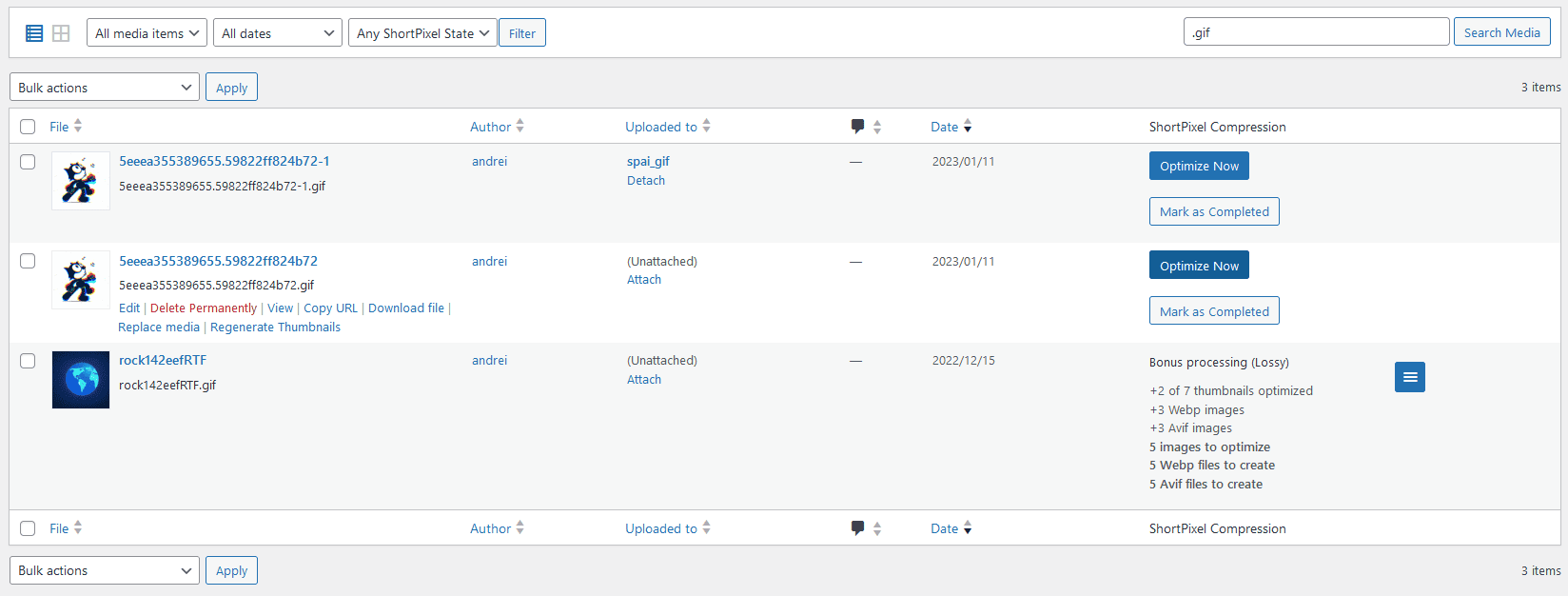
If you’re wondering, the plugin offers several advantages in GIF compression:
Firstly, ShortPixel gives you three compression levels to optimize GIFs while keeping them looking sharp and clear. Your animations stay crisp without losing their visual appeal.
It also handles optimization automatically, compressing GIFs as soon as you upload them to your site. No need to waste time with manual work.
ShortPixel’s smart compression significantly reduces file sizes while preserving the quality and impact of your GIFs. Plus, converting GIFs to WebP and AVIF formats ensures even better performance and results.
Using a plugin that serves images on the fly
Another method to optimize images, including GIF files, is to use a plugin such as ShortPixel Adaptive Images or a website accelerator like FastPixel.
Both solutions enable serving images through a CDN, automatically converting them into next-generation formats like WebP or AVIF based on the browser’s capabilities, significantly improving load times and overall website performance.
How to handle large animated GIFs online?
When dealing with large GIF files (several MBs), you have a few options:
Reduce dimensions
One approach involves reducing the dimensions in pixels of these larger GIFs.
Online tools like ShortPixel offer a convenient and effective means to perform this operation. Users can modify the resolution of the file before compression, reducing its dimensions while maintaining a proportional aspect ratio.
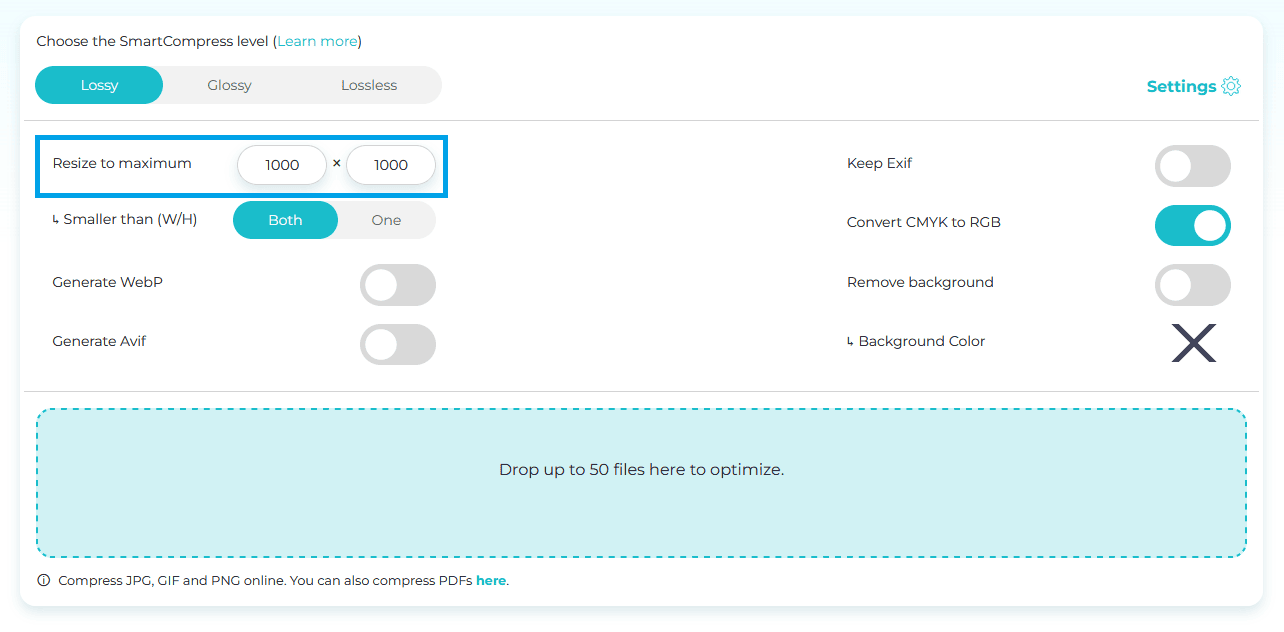
This reduction often results in a smaller file size, making the GIF more manageable for compression, online sharing, and web embedding.
Reduce frame count
Lessening the number of frames in the animation can significantly reduce file size.
Tools for this purpose are available both online and as Windows applications.
For example, by using EZGIF, the frame drop feature offers an efficient way to reduce the frame rate and file size of GIFs by selectively removing every second, third, or fourth frame.
This option is particularly beneficial for lengthy GIFs with high frame rates, allowing for a more manageable file size without significantly impacting the overall viewing experience.
Also, there’s an option to eliminate only duplicate frames. This identifies and removes consecutive frames that are identical or extremely similar, combining their display times.
This approach might not be needed for most GIFs, but it’s highly effective in cases where frame redundancy is significant. It helps create smoother, more efficient animations while reducing unnecessary file size.
What if the GIFs are still too large after compression?
GIF files, specifically animated ones, while popular, can sometimes remain too large even after compression.
In such cases, alternative formats like WebP and AVIF can be highly effective in reducing file sizes without compromising the quality of the animation.
Convert GIF to WebP
WebP is an image format developed by Google that supports animation and is widely supported by modern browsers, encompassing approximately 98.5% of current browser usage statistics.
When an animated GIF file format is converted to WebP, it often results in significantly smaller file sizes while maintaining similar visual quality. This format is optimized for web use and can help improve loading times for websites that host animated content.
For example, GIPHY – the most popular database for such files actually serves the .gif images as WebP.
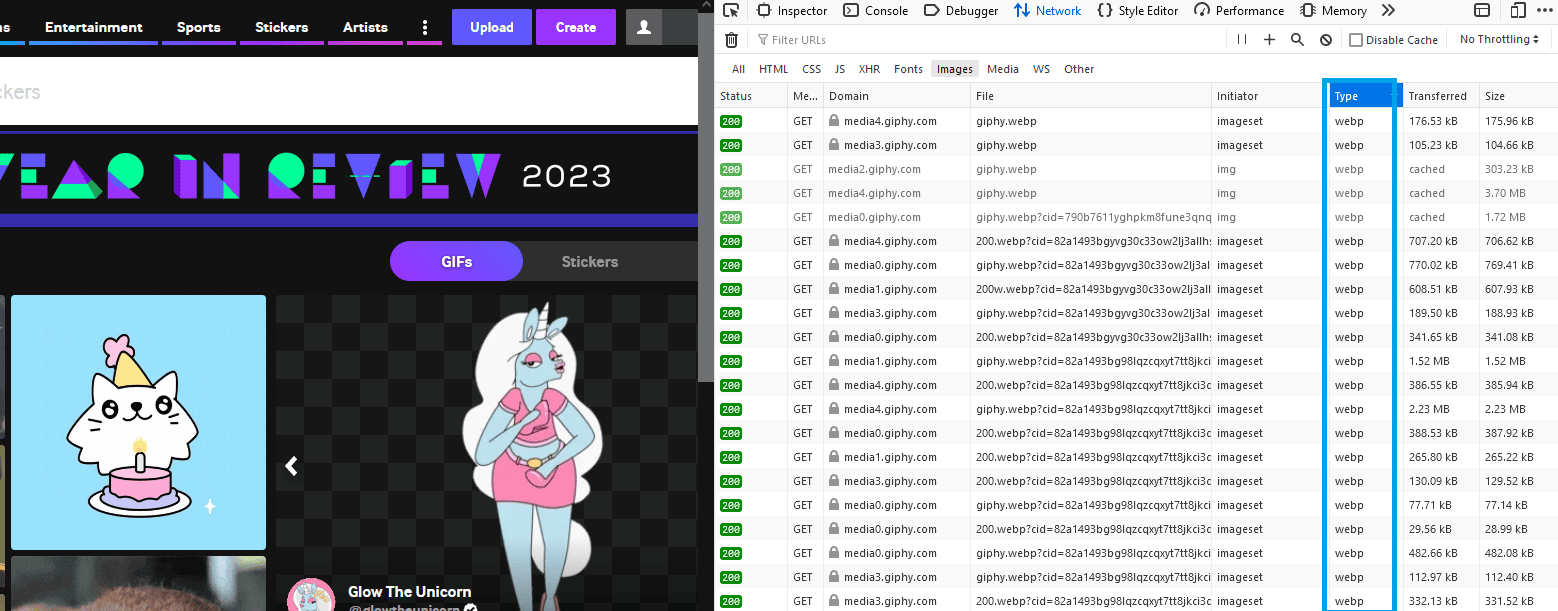
Convert GIF to AVIF
AVIF (AV1 Image File Format) is a relatively newer image format based on the AV1 video codec, known for its exceptional compression capabilities. Although still gaining traction, only ~87% of browsers currently support animated AVIF.
Platforms like WhatsApp have started utilizing animated AVIF as an alternative to traditional GIFs due to their superior compression, resulting in faster loading times and reduced bandwidth usage.
How to convert GIF files to WebP or AVIF?
Tip: AVIF typically yields the best results for significant reductions in GIF file sizes.
Converting GIFs to WebP or AVIF can be done using online tools like ShortPixel.
By leveraging these alternative formats, websites can provide a more efficient user experience when displaying animated content, catering to varying browser capabilities while minimizing file sizes for faster loading times.
Let’s look at the example below:
The clear winner here is the AVIF file. The compressed GIF file was approximately 18.25% smaller than the original, while the optimized AVIF file cut the size in half, showing impressive efficiency in file size reduction.
Summary
While animated GIFs are a fun and expressive medium, their technical limitations necessitate careful management. With the right tools and knowledge, one can optimize GIF animations for better performance and broader compatibility.
Compress GIF files for free!
Enhance GIF files effortlessly with ShortPixel, an all-in-one online tool that optimizes, resizes, and seamlessly converts to WebP or AVIF formats.
FAQs
What is a GIF file?
A GIF file is a type of image format that supports both static and animated content. The acronym stands for Graphics Interchange Format. It’s widely used because it can display a series of images or frames in sequence to create animations, making image GIF format perfect for short loops or simple motion graphics. GIFs are also popular for memes, reaction clips, and small animations due to their relatively small file size and ability to play automatically in most browsers.
How long can animated GIFs be?
Animated GIFs don’t have a strict time limit, but their length depends on the file size and the number of frames. The longer the animation, the larger the file, which can affect loading times and compatibility on certain platforms. Most platforms recommend keeping GIFs short and under a few seconds for better performance.
What are animated GIFs used for?
Animated GIFs are used to share short, looping animations or clips, often for entertainment, communication, or storytelling. They’re popular for memes, reaction expressions, tutorials, advertisements, and simple visual effects that grab attention quickly. Their ability to play automatically without needing extra plugins makes them a go-to choice for quick, engaging content online.
Are animated GIFs copyrighted?
Yes, animated GIFs can be copyrighted if they include original content like artwork, animations, or video clips. Using a GIF created by someone else, especially one based on movies, TV shows, or other media, might infringe copyright unless it’s considered fair use, like for parody or commentary. It’s best to use GIFs you create or those with permission for commercial purposes.
What are the limitations of GIF?
GIFs have several limitations. They only support 256 colors, which can reduce image quality, especially for detailed or colorful visuals. Their file sizes can become large for longer or high-resolution animations, leading to slower loading times. GIFs also lack audio, limiting their use for content that requires sound. Additionally, they may not be as efficient as newer formats like WebP or AVIF for animations.
